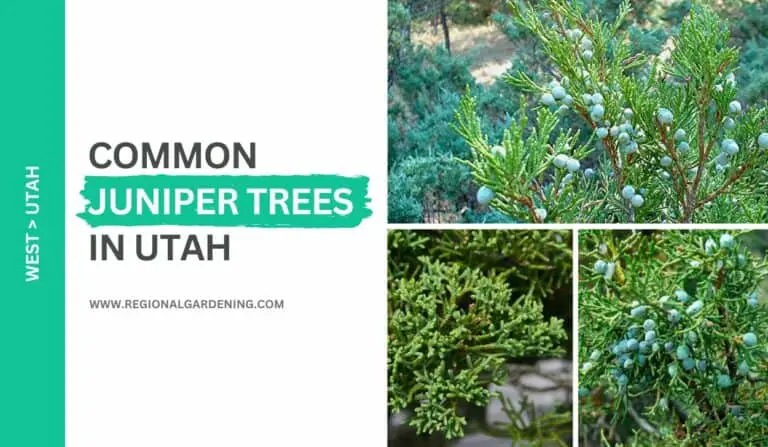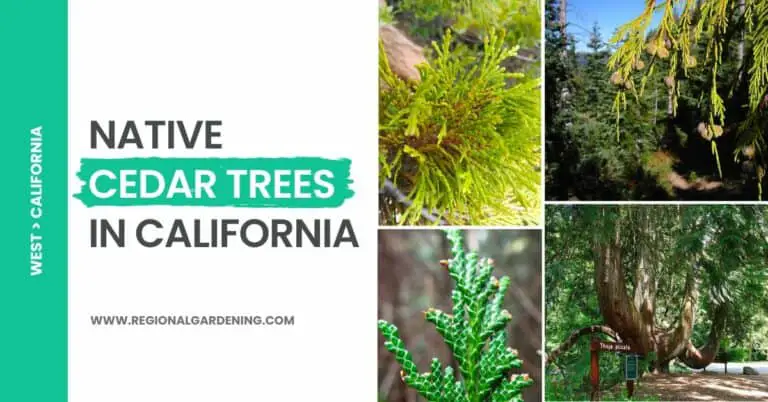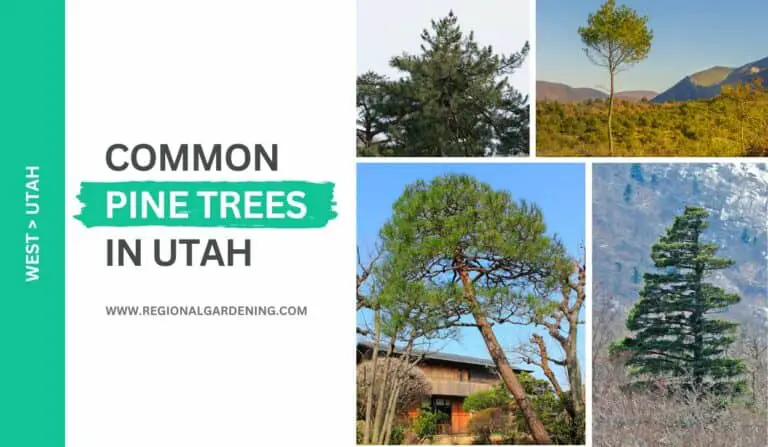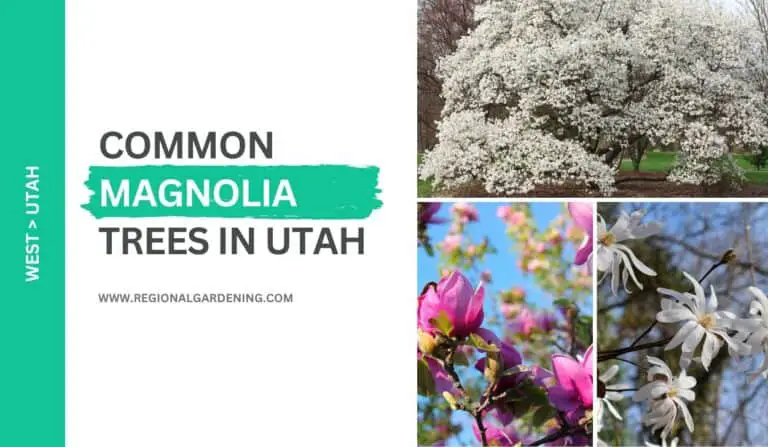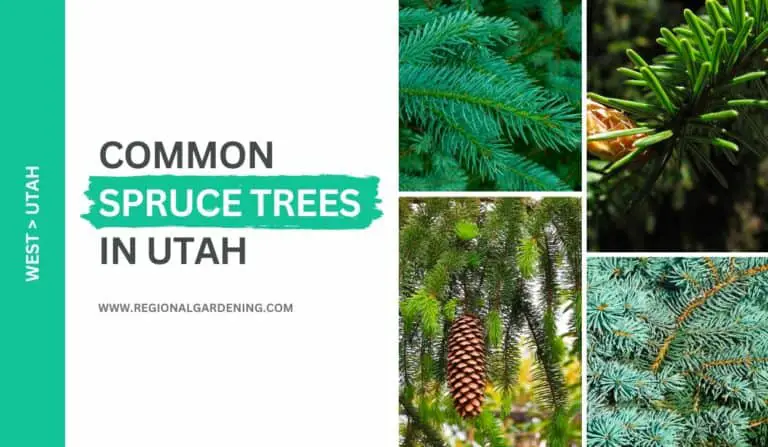16 Types of Native Oak Trees in California
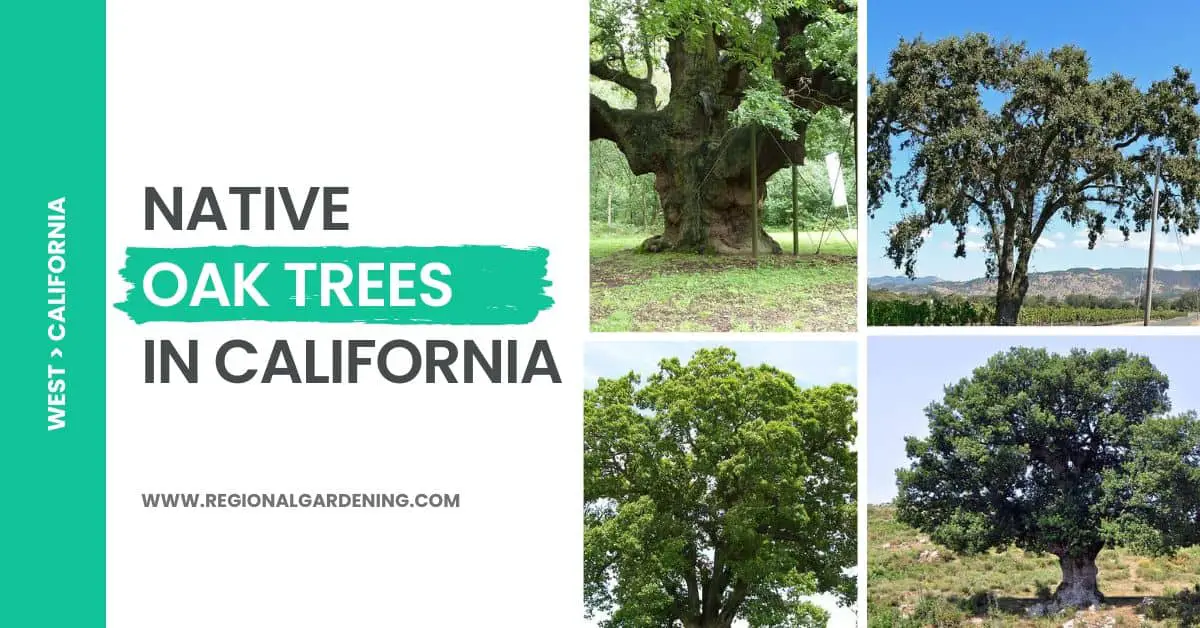
If you’ve ever taken a stroll through a California forest, chances are you’ve come across the towering giants known as Native Oak Trees. These beautiful trees are an important part of the ecosystem in California and are home to many different kinds of wildlife.
From the iconic Valley Oak to the rare and endangered Island Oak, each type has its own unique features and characteristics that make it a crucial component of California’s natural heritage.
In this article, we’ll explore the 16 types of native Oak trees in California along with their traits and habitats.
Let’s get started.
1. Coast Live Oak
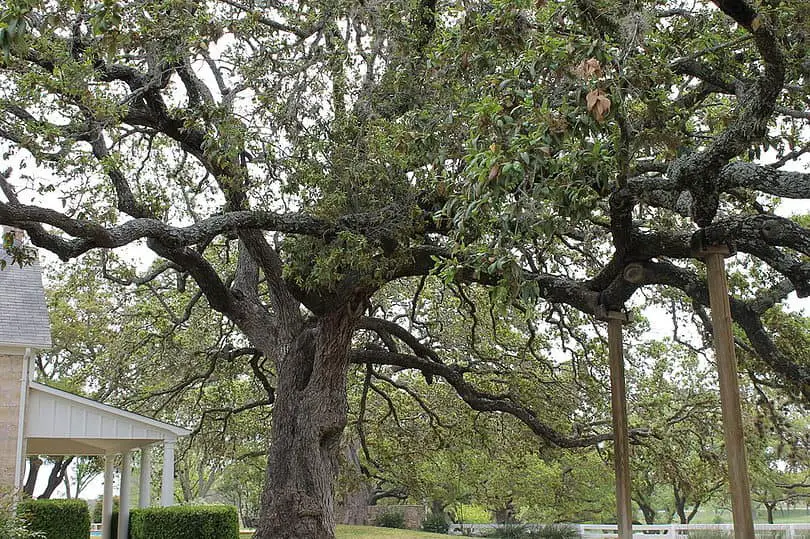
- Scientific Name: Quercus agrifolia
- Common Name(s): Coast Live Oak
- Mature Height: 30-80ft
- Uses: Firewood, Shade tree, etc.
The Coast Live Oak is evergreen, erect, small to medium-sized tree. It is native to California and can be found from Mendocino County to Baja California along the coast range. These trees can grow to be 9–24 meters tall and 30–1 m in circumference when fully mature.
The Coast Live Oak’s leaves are 2.5 cm to 7.5 centimeters in length, simple, alternating, leathery, and oval. The leaf’s upper surface is a deep green, while the lower surface is lighter. Gray in hue, the bark is thick and ridged throughout.
The Coast Live Oak can thrive in a wide range of light conditions, from full sun to deep shadow, and is even fireproof because of its thick bark and capacity to regrow after being destroyed. Birds, bears, deer, and other small mammals rely heavily on this tree for sustenance.
Coast live oak can be used for a variety of purposes, including firewood and shade. It can also share pollen with the California black oak, the island scrub oak, and the inner live oak.
2. Scrub Oak
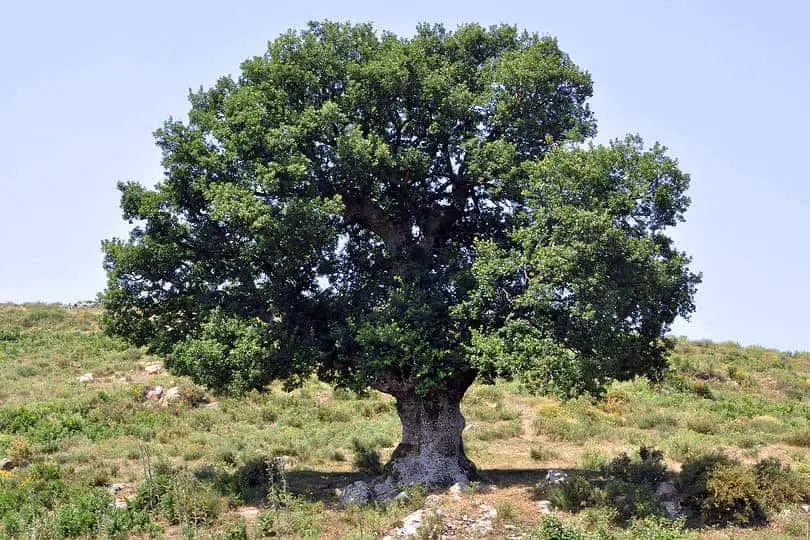
- Scientific Name: Quercus berberidifolia
- Common Name(s): Scrub Oak
- Mature Height: 1-4.5ft
- Uses: Ornamental, Fire Resistance
Scrub oak is small to a medium-sized shrub or small tree that can grow to be 1 m to 4.5 m tall. Its twigs and leaves are densely packed, forming a nearly impenetrable barrier.
The evergreen leaves are simple and alternate, oblong to elliptical, and 15 mm to 30 mm in length. The leaf tips are rounded, and the margins are spiny to toothed. The leaves have a green upper surface that is flat to wavy, and a greyish-green lower surface that is slightly hairy.
It produces an egg-shaped acorn that is 1 cm to 3 cm long. The acorn cup is bowl-shaped and contains approximately 33% of the nut. A scrub oak’s bark is smooth and grey.
Scrub oak can be found at elevations ranging from 300 to 1500 meters in the Coast Ranges, Sierra Nevada, and southern California mountains. Baja California is also home to this species. It does not tolerate shade. It is also used as an ornamental and is well-known for its fire resistance.
Other oak species known to hybridize with it include Engelmann oak, leather oak, Oregon white oak, Tucker oak, and valley oak.
The scrub oak used to be called Quercus dumosa, which is now the name of a rare species in southern California.
3. Canyon Live Oak
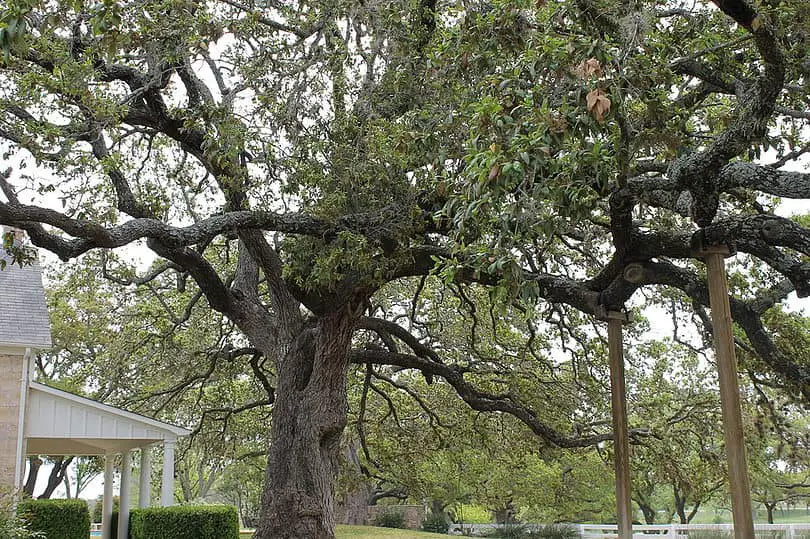
- Scientific Name: Quercus chrysolepis
- Common Name(s): Canyon Live Oak
- Mature Height: 15-70ft
- Uses: Firewood, Furniture, Pallets, etc.
The canyon live oak tree is found primarily in California, Oregon, Arizona, and Baja California, and is native to the western United States and Mexico.
This tree is a small to medium-sized evergreen tree with a single or multi-stemmed growth form. Trees can reach heights of up to 70 feet and a diameter of 5 feet when fully grown.
Their trunks are generally crooked and spread out, with dense and round crowns. The leaves are elliptic to egg-shaped, 2.5 to 10 cm long, and simple, alternate, and leathery. On the same tree, you can find both entire and spiny-toothed margins.
Acorns, which are light brown, egg-shaped, and 2.5 to 4 cm long, are the fruits of the canyon live oak. The bark is typically 4 cm thick, smooth to slightly furrowed, and smooth to slightly furrowed.
The canyon lives oak tree is drought and shade tolerant, but it is extremely vulnerable to fire. It is used as firewood, furniture, and pallets, and it also provides food and shelter to wildlife.
Native Americans also used acorn tannins to make edible mush. It is also known that the canyon live oak tree hybridizes with Palmer oak, island oak, and huckleberry oak.
4. Muller Oak
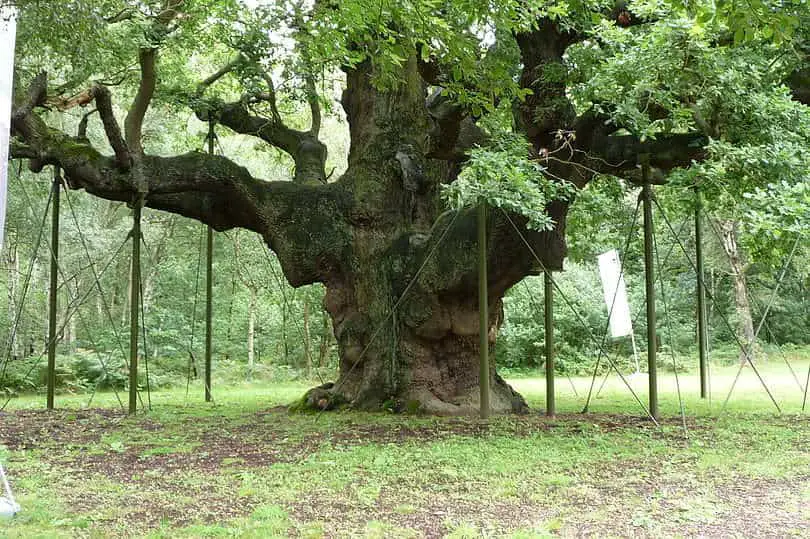
- Scientific Name: Quercus cornelius-mulleri
- Common Name(s): Muller Oak
- Mature Height: 3.3-8ft
- Uses: Windbreaks, Wildlife habitat
The Muller Oak is small to a medium-sized shrub that can reach heights of 1 to 2.5 meters. It stands out because the branches and leaves are so close together that they almost can’t be broken through.
Its leathery, oblong to egg-shaped leaves are evergreen, simple, and alternately placed, measuring 2.5 to 4 centimeters long. The leaf tips range from round to sharply pointed, and the margins have a few spines, or teeth, or are completely absent.
The upper surface of the leaves is hairy and yellowish-green to greyish-green, while the lower surface is whitish and densely hairy with yellow midrib.
Muller Oak acorns are brown and have a broad conical shape, measuring between 2 and 4 centimeters in length. The acorn cups are cup-shaped and range in diameter from 12 to 20 millimeters, enclosing approximately 33% of the nut. The cup scales are flat and covered in greyish hairs, while the twigs are covered in fine hairs. The bark is grey in color and smooth.
Muller Oak does not tolerate shade and has been known to hybridize with Engelmann Oak and Valley Oak. It grows in chaparrals and dry coniferous woodlands at elevations ranging from 1000 to 2000 meters, on granitic soils.
Its range goes from the San Bernardino Mountains to the coast, along the top of the Peninsular Ranges, and into Baja California. The Muller Oak is an excellent choice for wildlife habitats and windbreaks.
5. Blue Oak
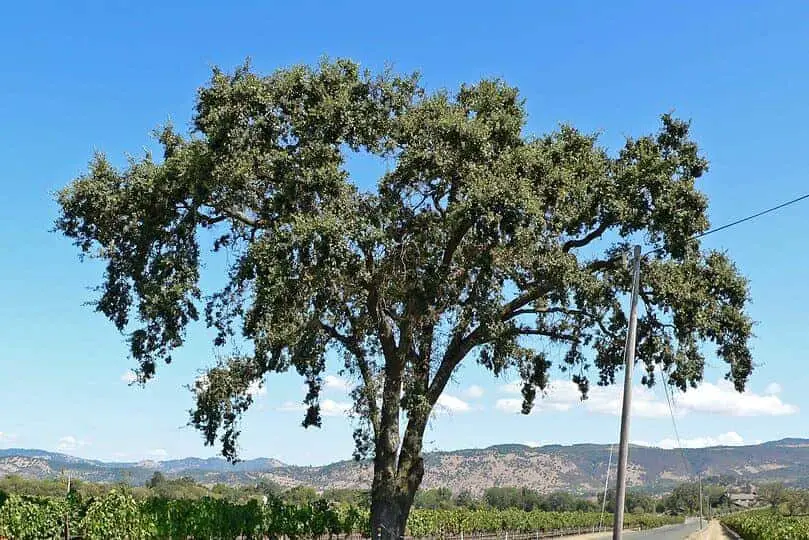
- Scientific Name: Quercus douglasii
- Common Name(s): Blue Oak
- Mature Height: 20-60ft
- Uses: Firewood, furniture, etc.
The Blue Oak is a small to medium-sized tree native to California, growing to a height of 6 to 18 meters and a diameter of 30 to 90 centimeters. The tallest of these trees, which can be found in southern Alameda County, stands 94 feet tall and has a diameter of 77 inches.
The Blue Oak has a short trunk with large, crooked, ascending, or spreading branches. Its crown is densely rounded, and its leaves reach the ground. The deciduous leaves are alternate, simple, and 4 to 10 centimeters long. They have 5 to 7 irregular round, oblong, or egg-shaped lobes. The leaves have a dull bluish-green upper surface and a pale bluish-green lower surface.
Acorns are brown, egg-shaped fruits that are 2 to 3 centimeters long. The saucer-shaped acorn cups measure.5 to.75 inches in diameter and enclose the nut’s base. The bark is approximately 1 inch thick, greyish in color, and checkered with flaky, thin scales.
The blue oak grows in woodlands and valleys in the foothills of western California mountains and is abundant in the Central Valley foothills. In the southern part of its range, it can be found from near sea level to 5,900 feet.
Blue oak has a few practical applications. Its wood is used to make firewood as well as furniture. Tool handles, fence posts, and interior paneling are also made from wood. Its foliage can be used as livestock forage, and its acorns can be used as wildlife food.
6. Leather Oak
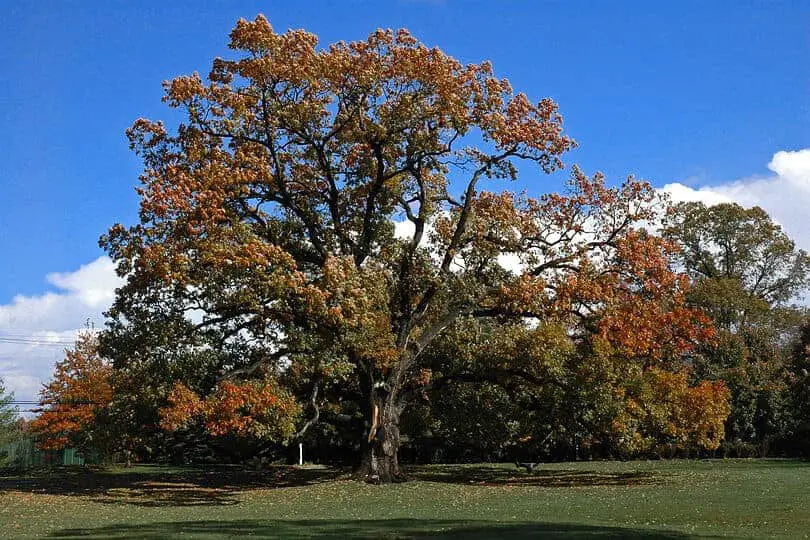
- Scientific Name: Quercus durata
- Common Name(s): Leather Oak
- Mature Height: 3-10ft
- Uses: Fencing, erosion control, etc.
The Leather oak is small to a medium-sized shrub that can reach heights of 1 to 3 meters. It has a dense tangle of branches and a rounded canopy.
The evergreen leaves are simple, alternate, and leathery. They have an oblong to elliptical shape and measure 12 millimeters to 3 centimeters in length. The leaf tips are pointed, and the margins range from spiny to entire and rolled over. The upper surface is greyish-green and hairy, while the lower surface is dull green and hairy.
The fruits are acorns with nuts that are brown, and egg-shaped with round tips. The acorn cups are bowl-shaped and 12-18 millimeters in diameter, enclosing approximately 33% of the nut. The bark is smooth and grey, and the twigs are hairy.
The Leather Oak grows in coniferous woodlands and chaparrals, primarily on serpentine soils at elevations ranging from 150 to 1,500 meters.
It appears to be shade-intolerant and recovers slowly from fire. This tree comes in two varieties: one that grows on serpentine soils and has strongly convex leaves, and one that grows on granitic soils and has slightly convex leaves.
It also crosses paths with Oregon white oak and scrub oak. The Leather Oak has several practical applications, including fencing, erosion control, and providing shelter for small animals.
7. Engelmann Oak
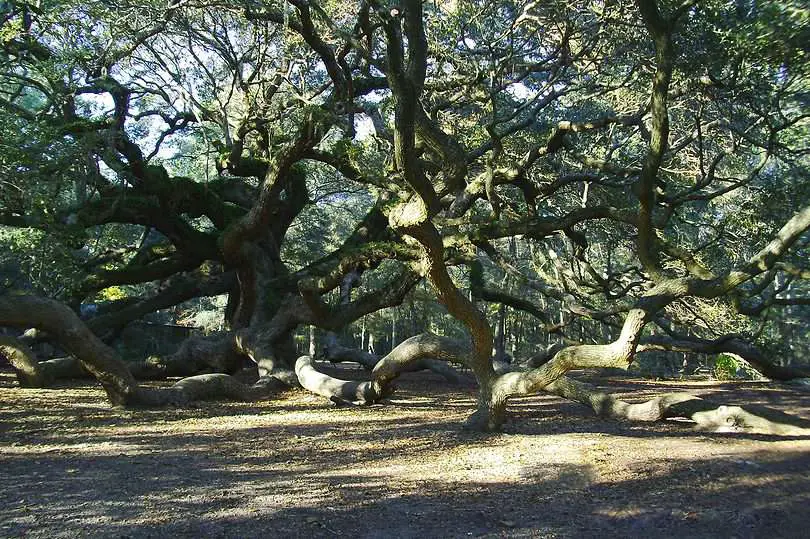
- Scientific Name: Quercus engelmannii
- Common Name(s): Engelmann Oak, Blue Oak
- Mature Height: 15-50ft
- Uses: Firewood, Cabinet making, etc.
The Engelmann oak is a single-stemmed tree that can grow to a height of between 15 feet (4.5 meters) and 4.5 meters (15 feet) (50 ft).
Because of the destruction of its habitat for human habitation and farming, this animal is critically endangered. Leathery in texture, the leaves of the Engelmann oak range in length from about 2.5 centimeters (1 inch) to 7.5 centimeters (3 inches).
They are oblong to egg-shaped, with their broadest part located above the leaf’s midpoint, and their margins can be whole, wavy, or serrated. The upper side is a dull bluish-green, while the underside is lighter in color and hairy when the creature is young.
The Engelmann oak has thick, furrowed bark that is covered with thin, grey scales. This tree is endemic to California, where it grows naturally on the arid foothill slopes and mesas between the coast and the mountains in southwestern California, at elevations below 1,300 m. (4,200 ft). It can hybridize with scrub oak and Muller oak and has a low risk of catching fire.
The wood of the Engelmann oak is excellent for use in both fireplaces and furniture. Its aesthetic value makes it a valuable component of any garden.
8. Oregon White Oak
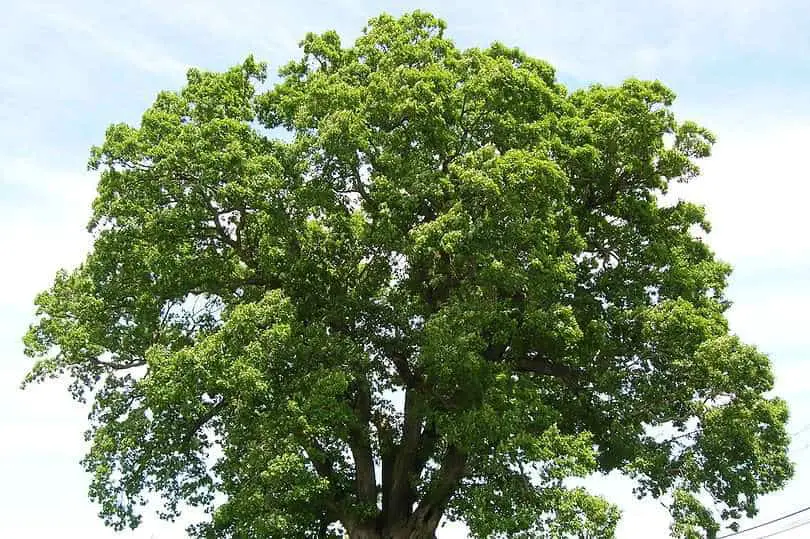
- Scientific Name: Quercus garryana
- Common Name: Oregon White Oak
- Mature Height: 25-90ft
- Flowers: Acorns
- Uses: Furniture, Cabinets, etc.
Native to the western regions of British Columbia and California, the Oregon White Oak is a straight, small to medium, single-stemmed tree. Mature trees typically range in height from 25 to 90 feet, with a diameter of 1 to 3 feet.
Openly growing trees have spherical crowns that extend to the ground and short trunks with big, twisted, ascending, or spreading branches.
The leaves are between 7.5 and 10 centimeters (3 and 4 inches) in length, and they have an elliptical to egg-shaped shape. The upper surfaces of the 5–9 lobes are dark green and lustrous, while the lower surfaces are light green; the lobes themselves are rounded and whole to coarsely serrated.
Acorns, the fruit of this tree, range in length from around 2 centimetres (.75 inches) to 3 centimetres (1.25 inches) and are brown with an egg shape. The bark is also thin, scaly, and a pale grey color.
Oregon white oak can survive in the mild shade and regrows after being burned or hacked. Its acorns are a major food source for many birds and mammals, and the foliage is tasty to both wildlife and livestock.
It’s also a staple material for building things like cupboards and tables out of wood. Brewer Oak (Q. g. var. brewer) is a subspecies of an oak tree that grows as a shrub between 900 and 2,300 meters (3,000 and 7,000 feet) in altitude (7,500 ft).
Scrub oak, blue oak, leather oak, valley oak, and Sadler oak are some of the other oak trees in California that can hybridize with Oregon white oak.
9. Tucker Oak
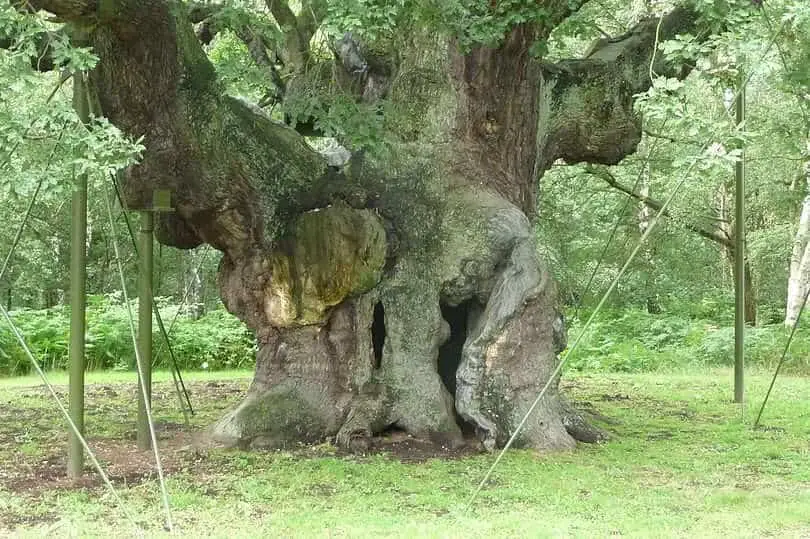
- Scientific Name: Quercus john-tuckeri
- Common Name(s): Tucker Oak
- Mature Height: 6-20ft
- Uses: Firewood, Bonsai, etc.
Tucker Oaks are small to medium-sized trees or shrubs (they can get as tall as 6 meters) (20 feet).
Leaves range in shape from oblong to elliptical and are 12–28 mm in length on this evergreen, simple, alternating, leathery plant. Round at the base and broadening towards the tip, the leaf bases are distinctive. Upper surfaces are dark greyish green and covered with fine hairs, while lower surfaces are lighter greyish green and irregularly spiky or serrated.
Acorns, the tree’s fruit, range in size from 1 to 3 cm and are brown with an egg- to cone-shaped appearance. The acorns’ bowl-shaped cups have a width of 10 millimeters to 15 millimeters and cover about a quarter of the nut.
The twigs are hairy, while the bark is smooth and grey. The Tucker Oak can be found in the southern interior of the Coast and Transverse Ranges, where it thrives in dry coniferous forests and chaparrals at altitudes between 900 and 2,000 meters (3,000 and 6,500 feet).
Hybridization has been observed with scrub oak, blue oak, and valley oak, and it is shade intolerant. Tucker Oak is commonly used as firewood and for bonsai.
10. California Black Oak
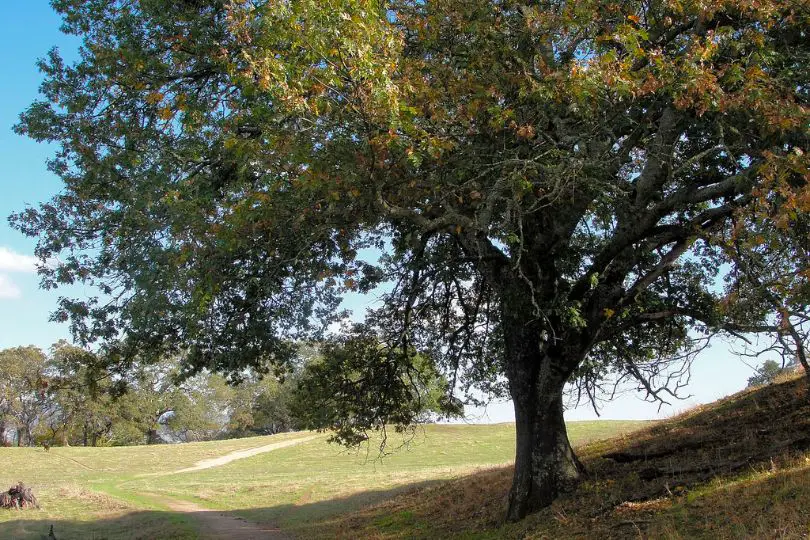
- Scientific Name: Quercus kelloggii
- Common Name(s): California Black Oak, Kellogg Oak
- Mature Height: 30-80ft
- Flowers: Acorns
- Uses: Hardwood timber, Dyes, etc.
The California Black Oak is a single-stemmed, small to medium-sized tree native to California. The trees can reach heights of 9-24m and diameters of up to 1-4ft.
The leaves are alternate, and deciduous, and have a shiny dark green upper surface and a pale green lower surface. The leaves are elliptical to egg-shaped, with 7 to 9 lobes and pointed or bristly edges. Acorns are brown, oblong to egg-shaped, and 0.75-1.3in long.
The bark is medium in thickness, furrowed, checkered, and greyish-black to black. From western Oregon to Baja California, the California Black Oak can be found in woodlands and coniferous forests.
It grows in pure stands in lower mountain areas and mixed coniferous forests between 200 and 8,000 feet above sea level.
The tree is initially shade tolerant, but as it grows older, it becomes shade intolerant.
It is the most important hardwood timber species in California, and it is also used for food, dyes, and wildlife cover. Native Americans used its acorns for food and its bark for dye.
11. Valley Oak
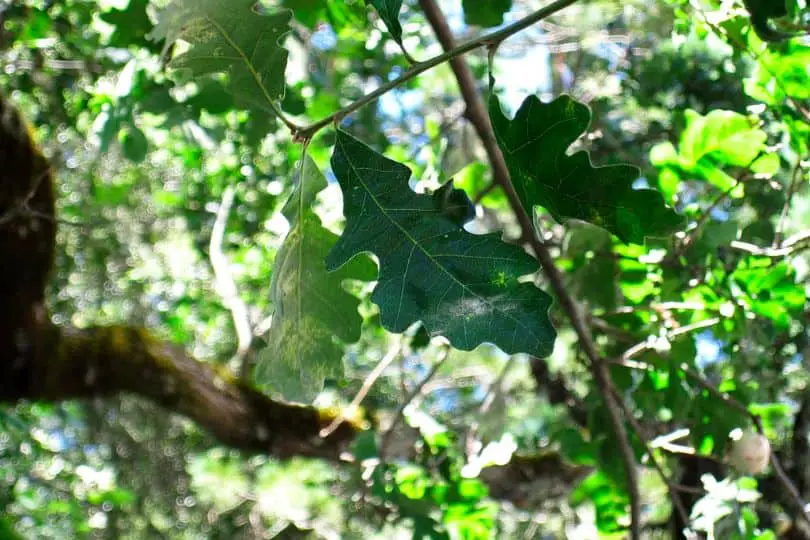
- Scientific Name: Quercus lobata
- Common Name(s): Valley Oak, California White Oak
- Mature Height: 30-90ft
- Uses: Firewood, Charcoal, etc.
Valley oak is a medium-sized, erect, single-stemmed tree native to California. With heights of up to 27 meters (90 feet) and diameters of up to 120 centimeters, it is the largest of the California oaks (4 feet).
It has a large, crooked trunk with ascending or spreading branches. It has dense, broadly rounded foliage, and its leaves are deciduous, alternate, and simple, measuring five to ten centimeters (2 to 4 inches) long. Six to ten round and egg-shaped lobes with deep sinuses form the leaves.
The bark is a light grey color that is deeply reticulated in alligator-like rectangular patches.
This is one of the few native oak trees in California that is not found naturally in any other state.
It lives in valley and foothill woodlands in the Central Valley, the Sierra foothills, and the Coast Ranges to the west. Most of the time, it grows in deep, alluvial soils, but it can also grow in shallower soils if its roots get enough water.
Valley oak has an intermediate shade tolerance and sprouts after being injured by fire or cutting.
It also provides important wildlife habitat, and native Americans used to grind its acorns into meals. Valley oak wood is primarily used for firewood and charcoal production, and it hybridizes with scrub oak, Muller oak, blue oak, Engelmann oak, Oregon white oak, and Tucker oak.
12. Island Scrub Oak
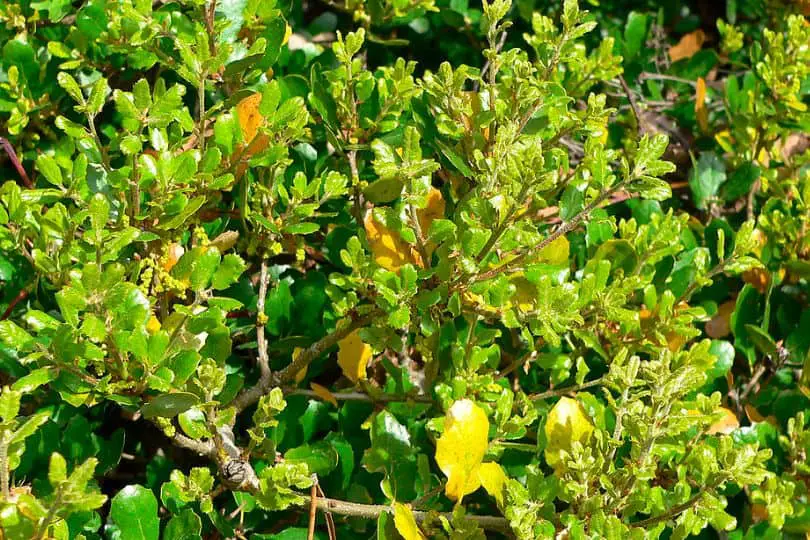
- Scientific Name: Quercus parvula
- Common Name(s): Island Scrub Oak, Santa Cruz Island Oak, Shreve Oak
- Mature Height: 3-50ft
- Uses: Landscaping, Wildlife Habitat
The Island Scrub Oak is small to a medium-sized shrub or small tree native to the Channel Islands and mainland coastal canyons and slopes below 1000m/3300ft in California.
It has leathery, alternate, oblong to egg-shaped leaves. They are usually entire, but occasionally toothed, and range in length from 3cm to 9cm. Upper leaf surfaces are olive green and hairless, while lower leaf surfaces are light olive green and hairless.
The fruit of the Island Scrub Oak is a brown acorn that ranges in size from barrel-shaped to egg-shaped and measures 3cm to 4.5cm in length. The acorn cup is bowl-shaped, about 12mm in diameter, and contains about 25% of the nut. The Island Scrub Oak’s bark is smooth and grey.
This tree comes in two varieties: the Santa Cruz Island Oak and the Shreve Oak. The Santa Cruz Island Oak is a rare shrub that grows 1m to 3m tall, whereas the Shreve Oak grows 4.5m to 15m tall and frequently hybridizes with Coast Live Oak and California Black Oak.
Island Scrub Oak is an excellent plant for wildlife habitat and landscaping, providing food and shelter for birds and small mammals.
13. Sadler Oak

- Scientific Name: Quercus sadleriana
- Common Name(s): Sadler Oak, Deer Oak
- Mature Height: 1-3m
- Flowers: Acorns
The Sadler Oak tree is primarily found in California and Oregon’s Klamath Mountains, at elevations ranging from 600 to 2,200 meters. It is a small to medium-sized shrub that grows to a height of 1 to 3 meters. It has a round, wide canopy made of branches that grow upward from the main stem.
The evergreen leaves are simple, alternate, leathery, oblong to elliptical, and range in length from 5 to 12.5 centimetres. The tips of the leaves are sharply pointed, and the edges have 20 to 28 teeth made of prominent, parallel veins that are evenly spaced. The leaves upper surfaces are shiny and green, while the lower surfaces are pale green and slightly hairy.
The Sadler Oak produces acorns, which are brown, egg-shaped, and 15 to 20 millimeters long. The acorn cups are cup-shaped and range in diameter from 10 to 17 millimeters, enclosing approximately 33% of the nut. The cup scales are hairy, warty, and flat. The Sadler Oak’s twigs are slender and flexible, and their bark is smooth.
It grows in the understory of conifer trees, but it can also grow on sunny, dry ridges and serpentine soils. The Sadler Oak can hybridize with Quercus garryana var. breweri, which grows in the same montane chaparrals.
14. Desert Scrub Oak

- Scientific Name: Quercus turbine/la
- Common Name(s): Desert Scrub Oak
- Mature Height: 6-23ft
- Uses: Firewood, Fuel, etc.
The Desert Scrub Oak can be either a small shrub or a small tree, growing to a height of 2 to 7 meters, and forming dense thickets.
The leaves are 15–30 millimeters in length, simple, alternating, leathery, and either sharply pointed or broadly rounded at the apex, with spiky or coarsely serrated margins. The upper sides of the leaves are grayish or yellowish green, while the underside is yellowish green with yellow hairs.
The acorns produced by the Desert Scrub Oak are 12–25 mm in length, cylindrical to egg-shaped, with a yellowish-brown color. A quarter of an acorn nut is contained within a bowl-shaped cup that is 8 to 12 millimeters in diameter. The scales on a cup are thin, flat, and irregularly warted. The twigs are hairy, but the bark is a dull grey.
This tree grows naturally in southeastern California, western Texas, and Baja California. In Baja California, it grows in inner forests near the edge of the desert. The Desert Scrub Oak is a useful fuel source and does not tolerate shade.
15. Huckleberry Oak
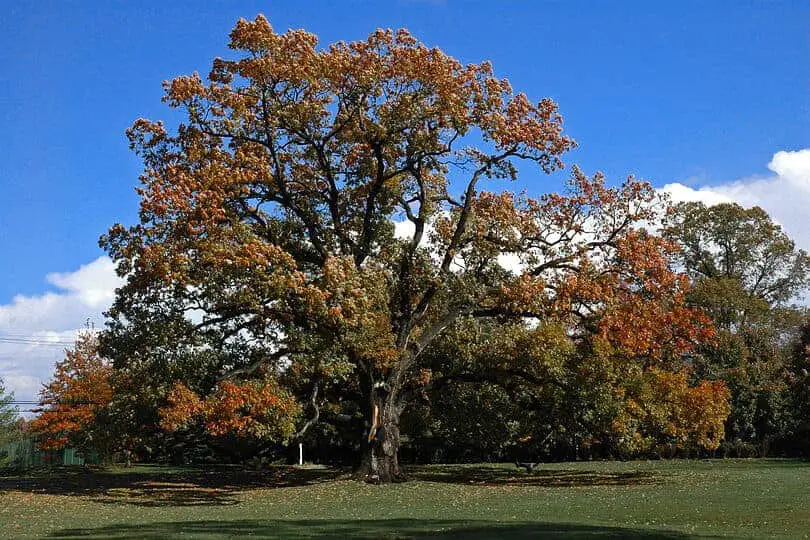
- Scientific Name: Quercus vacciniifolia
- Common Name(s): Huckleberry Oak
- Mature Height: 1-4 ft
- Uses: Not typically used for lumber
The huckleberry oak is a densely branched, low-growing shrub.
The leaves are simple, alternating, leathery, and evergreen. They are between 12 and 30 millimeters in length and oblong to elliptical. The leaf tips can be rounded or pointed, and the margins are usually whole but sometimes include a few spiky teeth. The leaf undersides are a pale green color and are either hairless or have scant hairs, while the top sides are dark green and hairless.
The acorns range in shape from spherical to egglike and are around 12 millimeters in length. The acorns’ cups have a diameter of around 12 millimeters and enclose nearly a quarter of the nut inside. The bark on the branches is smooth and grey, and the twigs are pliable.
The Sierra Mountains and Northwest California are home to huckleberry oak trees, although you can also find them in Oregon. It is most at home in cool, wet places like the forests, woodlands, and chaparral of the mountains and sub-Alps. Unlike most other California oaks, it prefers cooler, higher altitudes (900 m – 3000 m).
The huckleberry oak is resistant to recurrent fire and the harsh conditions of rocky soil and does not mind the sun. Many different animals feed on the acorns that the deer eat as they graze the leaves.
Both canyon live oak and huckleberry oak are capable of hybridization. For the most part, it is not possible to utilize the wood from this tree to make furniture.
16. Interior Live Oak
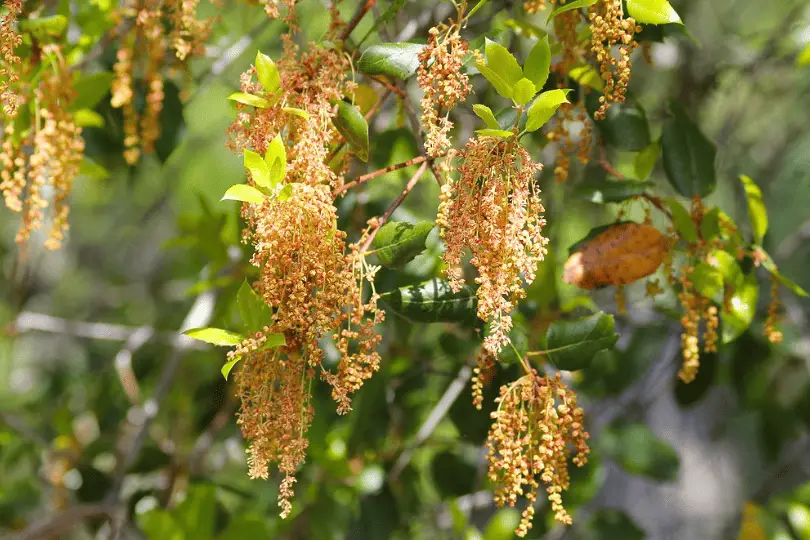
- Scientific Name: Quercus wislizeni
- Common Name(s): Interior Live Oak
- Mature Height: 9-23ft
- Uses: Firewood, Wildlife Habitat
The Interior Live Oak is a small to medium-sized tree native to California that grows in a variety of woodlands and chaparrals, primarily in the Coast Ranges and southern California mountains.
It is an evergreen tree with simple, alternate, leathery leaves that are oblong to elliptical, and 25-40 millimeters long.
The bark is thick, ridged, furrowed, and dark gray. The trees can reach up to 23 meters tall and 90 centimeters in diameter and can live to be over 200 years old. The acorns are brown, slim, conical to egg-shaped, and 2-4 centimeters in length.
The Interior Live Oak is a shade-tolerant tree and is resistant to fire due to its thick bark and sprouting capability.
It provides essential wildlife forage and habitat, and its shade gives summertime relief to livestock. Native Americans used acorns to make different kinds of food, and the tree is also used to make fires.
In areas that are prone to recurring fire, the tree can form shrubby thickets. It also mixes with the California black oak, the huckleberry oak, and the coast lives oak.
Native Oak Trees In California – Frequently Asked Questions (FAQs)
This section responds to some of the most frequently asked questions on various online forums about native oak trees in California.
What is the most common oak tree in California?
The most commonly found oak trees in California are Live Oak, Post Oak, and Bur Oak. However, out of these three only Live Oak is native to the region, and the other tow is considered to be naturalized over the years.
What are the native oak trees of southern California?
The native oak trees of southern California are Live Oaks and Engelmann Oak. Live oak includes different varieties like Canyon Oak, Coastal Oak, and Interior Live oak.
Similar Articles
- Native Pine Trees In California
- Native Cypress Trees In California
- Native Birch Trees In California
- Native Manzanita Trees In California
- Native Cedar Trees In California
- Native Maple Trees In California
- Native Fir Trees In California
- Native Hemlock Trees In California
- Native Spruce Trees In California
- Native Alder Trees In California
- Common White Bark Trees In California
- Native Juniper Trees In California
- Native Ash Trees In California
- Common Purple Trees In California
Sources
The Regional Gardening team makes sure that the information in our articles is accurate by only using sources that are known to be trustworthy. Some of these sources are peer-reviewed journals from government agencies, well-known universities, and scientific research organizations.
- California Forests, University Of California
- California Native Plant Society
- Native Plants, California Department Of Fish & Wildlife
- California Natural Diversity Database


